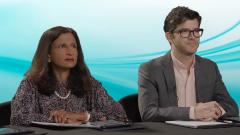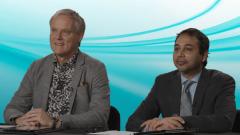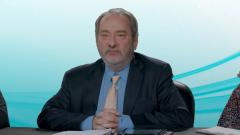
Review of Patient Subgroups in Transplant-Ineligible NDMM
Oncology expert panelists review patient subgroup analyses for MAIA and SWOG0777 studies, investigating treatments for transplant-ineligible patients with newly diagnosed multiple myeloma.
Episodes in this series

Transcript:
Robert Z. Orlowski, MD: Ajay, Ola mentioned frail patients.What do you do for those folks? The MAIA study had quite a few patients who would’ve been considered frail. Do you try to get 3 drugs in them? Can 2 drugs sometimes still be a reasonable option there?
Ajay K. Nooka, MD: This is a great question. I’ll give you the context. My epidemiology major wakes up at times, and this is one of those times. The reason I bring us back to the context is we have 35,000 people diagnosed with myeloma every year. We take the transplant-eligible patients; only 10,000 people get transplants, which is 30%. So 70% of the people don’t get transplants, which means this is the patient group we need to discuss more in detail. They don’t see you or me, but these are the patients who are treated in the community. And emphasizing what Cesar mentioned before, you only get 1 shot. You put the best foot forward for these patients because if you don’t offer the first treatment right, there’s an attrition rate of 40%. So you have 1 chance, and how do you want to utilize the best option for these patients?
We have heard the DRd [daratumumab, lenalidomide, dexamethasone] data from MAIA. We heard the data from the SWOG S0777 trial. From both these trials, we have data showing that 3 drugs are better than 2. The way I view this is the Rd [lenalidomide, dexamethasone] with the longest follow-up is exactly the same. The control arm has performed the same across both these trials, which is clearly saying that we could escalate the improvement in the PFS [progression-free survival] by adding a third drug. I guess everybody agrees with that. Now adding the third drug, can everybody tolerate it? That’s the biggest question that comes into the frailty scenario here. How do you determine frailty? We have a saying that there are more frailty scores than patients that we have. The one that is simple, that can be evaluated, right now we all do the visual test. We need more objective tests, there is no doubt about it. We need to invest more time into having that simple test in the clinic for who fits the criteria of frailty, and how can we make those treatment determinations about whether the patient would be eligible for a doublet, whether the patient would have 3 drugs? And as Ola mentioned, there are some patients in this transplant-ineligible group who could get away with 4 drugs. That determination of where this patient fits into the fit, intermediate, and frail [groups] is so important, which we ignore a lot of times.
Robert Z. Orlowski, MD: Fair enough. Cesar, any subgroups in particular for which you would think about one induction over another? High risk for example vs standard risk comes to mind. Do you try to give a proteasome inhibitor to the high-risk patients, or not really? What do you think about daratumumab in high risk?
Cesar Rodriguez, MD: I am an early adopter, but when it comes to high risk and the benefits of daratumumab in high risk, I’m still waiting to see a bit more data. I do believe that people who have high risk, I will try to do a proteasome inhibitor whether or not I use an anti-CD38 agent. But an interesting thing that is being presented at ASH [American Society of Hematology annual meeting] this year is from the MAIA study. There have been some subgroup analyses focusing on older people above the age of 75; people with high-risk cytogenetics based on IMWG [International Myeloma Working Group] criteria, which would be translocation 4;14, 14;16, or 17p deletion, to try to see if daratumumab, lenalidomide, and dexamethasone has a benefit in these populations; and people with extramedullary disease or stage III. The subgroup analyses from the MAIA study are showing that there is a tendency and a benefit in these subgroups. So this is starting to change my mind a bit, and maybe the proteasome inhibitor is not as necessary now that we’re incorporating an anti-CD38 agent. It’s taken me a bit more time to assimilate it because I’ve been entrenched in having to have a proteasome inhibitor for anybody who’s high risk. But as we’re getting more information on these new agents and how they could potentially also have a benefit in high-risk disease, I might start being a bit more relaxed in having to give a proteasome inhibitor.
C. Ola Landgren, MD: Bob, can I bring up one thing? This discussion is similar to the discussion we had 10 years ago or something like that, with people arguing 2 vs 3 drugs. Now we’re talking 3 vs 4 drugs, it’s the same, just 1 number higher. If we think about this discussion, 2 vs 3 drugs, there was this school of thought that if patients are standard risk, 2 is enough. And if you’re high risk, you have to do 3. That was the more conservative, the late adopters, slow adopters. You said, Cesar, you are an early adopter. So the early adopters, they said you need to do 3 drugs for all the patients. If you look in detail at how the studies read out, if you had high-risk disease, if you got 2 drugs, that was of course significantly worse vs if you got 3 drugs. But what’s also interesting is that in the standard-risk group, if you only gave them 2 drugs, they had a much stronger worsening of the outcome vs if you had given them 3 drugs. The difference between 2 and 3 drugs in the standard-risk patient population was much bigger. So the data showed that 3 drugs are better for everybody. If you think about that, should everyone get 4 drugs? And the standard risk are the ones who should get 4 drugs because they benefit even more. That’s a controversial question, but it’s an interesting one.
Cesar Rodriguez, MD: You make a good point, and I’m going to elaborate even more. If it’s standard risk and we’re trying to use the best punch we have, should we be cutting back, or should we still be doing the 4 lines? At [Mount] Sinai, I’m going to put in a little plug for the study we have for frail patients or transplant ineligible, where we are doing daratumumab-VRd [bortezomib, lenalidomide, dexamethasone] in this population to try to understand if it’s safe, and what the responses are using a quadruplet regimen in transplant-ineligible or frail patients. But to also comment on Ajay’s comment he made earlier that 3 is better than 2, I think when we have a patient who comes to us with a new diagnosis of myeloma, whether they’re young or older, a lot of times they’re going to be in bad shape. And they might look frailer than what their baseline is. The moment you start treating them, by the second or third cycle, their performance status is going to improve significantly. So whether you think these patients are going to tolerate a triple regimen or a quad, maybe if they are that frail at the beginning, the first cycle you can start a bit more conservative, and then with the second cycle incorporate a third or a fourth agent to that regimen.
Robert Z. Orlowski, MD: I was going to say, according to Ola’s schedule, in 10 years we should be talking 5 drugs vs 4 drugs. Is that right?
Amrita Krishnan, MD: Or 8?
C. Ola Landgren, MD: The answer is no, because at some point we will reach some form of equilibrium where we have to start thinking about taking off the drugs. Think about how can you develop better and better when we are so good; it’s going to be harder to develop therapies. But if there is a really good drug, doesn’t that mean it’s time to take out the weaker one?
Amrita Krishnan, MD: Yes and replace.
C. Ola Landgren, MD: It’s going to go backward. I don’t think we’re going to do 5 or 6 or 7 [drugs]. We’re going to have maybe 4, but get rid of one of the existing ones. Maybe dexamethasone is one, I like that one.
Amrita Krishnan, MD: To be honest, it’s much more about immunotherapy-based strategies, and recognizing it’s more about how can you augment your own immune environment. All the other drugs are poor surrogates to do that right now, but we have some future ones. To put a plug in also for some of the bispecifics, using them earlier in the course of disease for example may be interesting.
Robert Z. Orlowski, MD: We have a study we’re about to open, which is a multicenter trial, that will look at a BCMA [B-cell maturation antigen] bispecific as a single agent in a window design for newly diagnosed patients. I’m sorry, Ajay. You were going to make a comment and I cut you off, so please go ahead.
Ajay K. Nooka, MD: I was about to say understanding that from a frailty perspective why the patient is frail, is it the disease comorbidity that is making that patient frail? In those patients, I would argue the other way, saying you probably should treat them more aggressively so that you take off whatever the disease burden is making them frail. That probably would give them a faster recovery than being conservative and taking a more simple approach to the disease.
Amrita Krishnan, MD: But the frailty indexes can’t account for that, right? You do your 6-minute walk. Well, if you can’t walk because you have incredibly bad bone disease….
Ajay K. Nooka, MD: Yes, absolutely. It’s a dynamic evaluation, it’s not a one-time evaluation. That’s an important point.
Robert Z. Orlowski, MD: For the home audience, one thing we’re all thinking but nobody has yet said, is that in these frail older patients, you don’t get as many second and third lines of therapy. Sometimes the front line is your best shot at them, because unfortunately, fewer of them make it to the second line compared to transplant-eligible [patients]. So you want to give them the best shot.
Transcript edited for clarity.
Newsletter
Stay up to date on recent advances in the multidisciplinary approach to cancer.






















































































